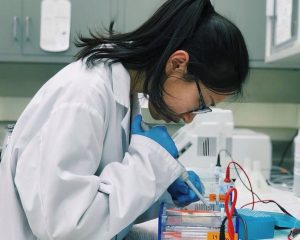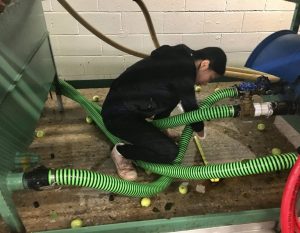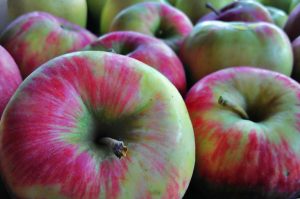Pathogenic bacteria that stubbornly lurk in some apple-packing facilities may be sheltered and protected by harmless bacteria that are known for their ability to form biofilms, according to Penn State researchers, who suggest the discovery could lead to development of alternative foodborne-pathogen-control strategies.
 That was the key finding that emerged from a study of three tree-fruit-packing facilities in the Northeast where contamination with Listeria monocytogenes was a concern. The research, done in collaboration with the apple industry, was an effort to better understand the microbial ecology of food-processing facilities. The ultimate goal is to identify ways to improve pathogen control in the apple supply chain to avoid foodborne disease outbreaks and recalls of apples and apple products.
That was the key finding that emerged from a study of three tree-fruit-packing facilities in the Northeast where contamination with Listeria monocytogenes was a concern. The research, done in collaboration with the apple industry, was an effort to better understand the microbial ecology of food-processing facilities. The ultimate goal is to identify ways to improve pathogen control in the apple supply chain to avoid foodborne disease outbreaks and recalls of apples and apple products.
“This work is part of Penn State’s efforts to help producers comply with standards set forth in the federal Food Safety Modernization Act, often referred to as FSMA,” said researcher Jasna Kovac, assistant professor of food science, College of Agricultural Sciences. “The Department of Food Science at Penn State, through research and extension activities, has an ongoing collaboration with the apple industry, led by Luke LaBorde, professor of food science.”
The research was done in collaboration with the apple industry, in an effort to better understand the microbial ecology of food-processing facilities. The ultimate goal is to identify ways to improve pathogen control in the apple supply chain to avoid foodborne disease outbreaks and recalls of apples and apple products.
 In the study, researchers sought to understand the composition of microbiota in apple-packing environments and its association with the occurrence of the foodborne pathogen Listeria monocytogenes. Their testing revealed that a packing plant with a significantly higher Listeria monocytogenes occurrence was uniquely dominated by the bacterial family Pseudomonadaceae and the fungal family Dipodascaceae.
In the study, researchers sought to understand the composition of microbiota in apple-packing environments and its association with the occurrence of the foodborne pathogen Listeria monocytogenes. Their testing revealed that a packing plant with a significantly higher Listeria monocytogenes occurrence was uniquely dominated by the bacterial family Pseudomonadaceae and the fungal family Dipodascaceae.
“As we investigated the properties of these microorganisms, we learned that they are known to be very good biofilm formers,” said lead researcher Xiaoqing Tan (upper left), a recently graduated master’s degree student in food science and a member of the Penn State Microbiome Center, housed in the Huck Institutes of the Life Sciences. “Based on our findings, we hypothesize that these harmless microorganisms are supporting the persistence of Listeria monocytogenes because they protect the harmful bacteria by enclosing them in biofilms. We are testing this hypothesis in a follow-up study.”
The findings of the research, published today (Aug. 21) in Microbiome, provide insight into the Listeria contamination problem and may lead to researchers and the apple industry getting closer to solving it, Kovac believes. Equipment in fruit-processing plants — such as brush conveyors — have a poor sanitary design that makes them difficult to clean and sanitize, she pointed out. She and LaBorde plan to work with the apple industry to devise more effective cleaning and sanitizing strategies.
Researchers collected samples in apple-packing facilities in which Listeria monocytogenes has been persistent. They discovered that harmless bacteria may be sheltering the pathogens.
“Following up on these findings, we are experimenting with some of the nonpathogenic strains of bacteria that are not harmful to humans to see whether they can be used as biocontrols,” she said. “Once applied on the surfaces of the equipment in these environments, they may be able to outcompete and suppress Listeria, thus reducing food-safety risks and potential regulatory action. We are still exploring that approach in a controlled laboratory environment. If it proves to be feasible, we would like to test it in apple-packing and processing facilities.”
The challenge presented by microbiota possibly sheltering Listeria monocytogenes is not limited to fruit-processing facilities or produce, Penn State researchers suspect. They will soon begin analyzing microbial communities in dairy-processing facilities to determine the microbial composition and ecology of these environments.

